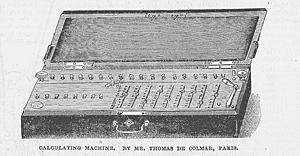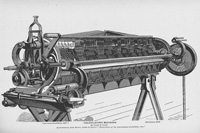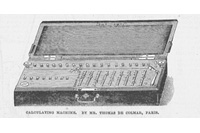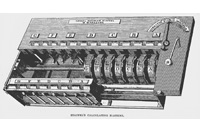Calculator
 This is an image of an arithmometer exhibited at the first London International Exposition of 1851. This machine (the world's first mass produced gear calculator) was the one that C. X. T. de Colmar invented in 1818, and then improved over a long period of time.
This is an image of an arithmometer exhibited at the first London International Exposition of 1851. This machine (the world's first mass produced gear calculator) was the one that C. X. T. de Colmar invented in 1818, and then improved over a long period of time.
In 1642, B. Pascal of France invented the oldest surviving mechanical calculator. In those days, Europe had monetary units with complicated counting systems. To help his father, a tax commissioner experiencing difficulty in calculating, Pascal manufactured a prototype of a gear calculator called the Pascaline. On its body, the device had several dials representing different columns of numbers. It was characterized by the fact that entries of numerical values to be added or subtracted according to the column carried over numbers from one position to the next automatically, through the use of internal gears. This device featured a method of performing subtractions using complement techniques, and a method in which a division was conducted by repeated additions and subtractions while number columns were moved. These methods were employed for a wide variety of calculators subsequently developed. Actually, the principle used for today's up-to-date computers is identical to Pascal's idea.
In 1693, some 30 years after the death of Pascal, G. W. Leibniz successfully created a device that performed not only additions and subtractions but also multiplications and divisions fully automatically with the use of stage gears. Also, he contributed to the development of the binary system, which is widely used in the digital computers today.
The above arithmometer was the world's first mass produced gear calculator. In those days, a hand-operated desk calculator like this was often used.
The first concept of a programmable automatic calculator was planned by C. Babbage of England. At first, he worked hard on creating a difference engine, a calculator designed to enable polynomial calculations for numerical table. Behind his efforts lays the fact that, although a vast amount of numerical table was required for navigation and other activities in those days, the calculation was performed manually, causing frequent mistakes.
Despite his efforts, Babbage himself did not complete the difference engine. It was completed by the Swedes G. Scheutz and his son Edward in 1843. They created improved versions of the engine in 1853 and 1859. The 1853 version won a gold medal at the first Paris International Exposition of 1855. The 1859 version, which was constructed by B. Donkin of England, was used for compiling the "Life Table" of the country. This device was exhibited at the second London International Exposition of 1862, and is currently stored in the Science Museum, London. The image on the right depicts G. B. Grant's difference engine exhibited at the Philadelphia International Exposition of 1876.
In 1837, Babbage tried to develop a more general analytical engine that performed calculations according to given programs. This engine was designed to enable calculation results to be stored in a gear case serving as mechanical memory, and to allow a series of operations results to be retrieved. Although he just conceived the design, it was an important step in the history of computers in that it separated formulas from calculation results.
- References:
Campbell-Kelly, M, Aspray, William.; Yamamoto, Kikuo (tr).: Konpyuta 200nenshi (Kaibundo shuppan, 1999)<M154-G1022>
Goldstine, Herman Heine; Suekane, Ryota (et al) (tr).: Keisanki no rekishi: Pasukaru kara noiman made (Kyoritsu shuppan, 1979) <M151-46>
Hoshino, Tsutomu.: Dare ga doyatte konpyuta o tsukuttanoka (Kyoritsu shuppan, 1995) <M154-E1242>
Toya, Seiichi.: Keisan to keisan kiki no rekishi (Huji tanki daigaku shuppanbu, 1972) <M151-16>
Uchiyama, Akira.: Keisanki rekishi monogatari (Iwanami shoten, 1983) <M151-76>




